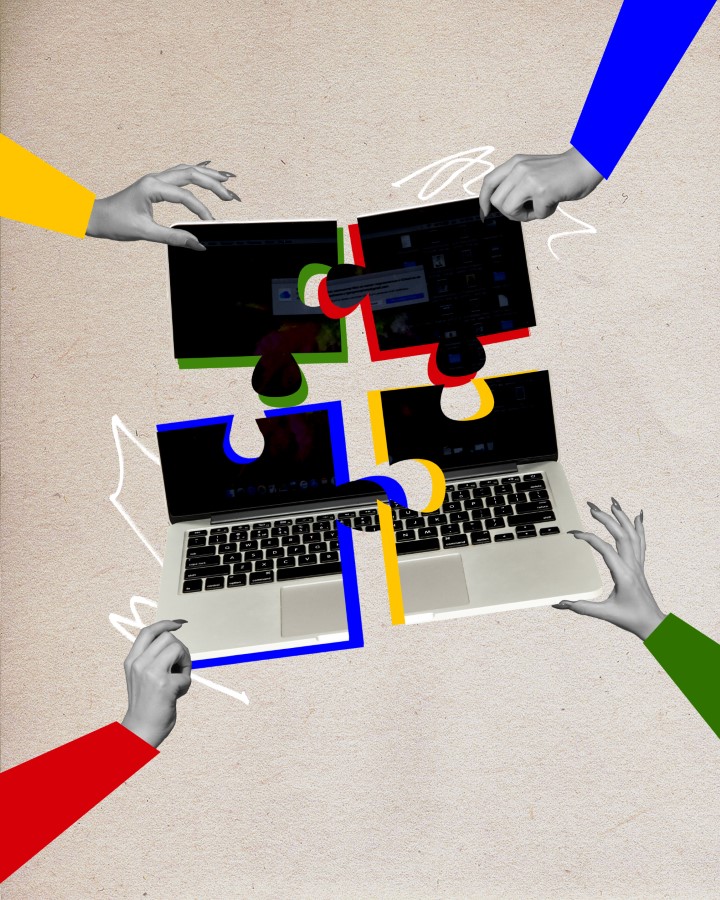Through the years, we’ve all heard hundreds of quotes about teamwork. People often discuss how effective cooperation and collaboration skills can create a more efficient workplace.
We hear it so often because it’s true. With the right combination of social skills, collaborative effort, and strong team leadership, businesses like yours have seen a 17% rise in productivity with a 21% rise in profitability1.
But teamwork doesn’t just happen.
It starts with the hiring process and continues through onboarding and training. Then, with the proper tools, your staff can put their heads together and work toward a team goal. When everyone works together, it’s more efficient and productive than any individual effort. That includes both onsite teams and remote teams spread across the world.
This article will walk you through five strategies to improve teamwork in your workforce.
1. Hire employees with complementary skill sets
You must keep teamwork in mind when it’s time to start building your team. Before you have a single interview with your first candidate, you should know what you’re looking for and how the different members of your team fit together.

That means hiring workers with complementary skills. When putting a football team together, you need a quarterback, offensive and defensive players, a kicker, etc. It’s the same when you’re putting together a business team.
What your ideal team player looks like will vary based on your needs. You might need a copywriter, digital artist, web designer, and ad sales representative all working together to launch a new e-commerce website.
Or you could need nurses with different skill sets, receptionists, and doctors with varied specializations when running a medical center.
Understand what you need from a team perspective and work that into your hiring search. Consider working with a consulting agency if you don’t know where to start. You’ll hit the ground running with an efficient and profitable team.
2. Encourage teamwork during onboarding and training
Encourage strong teamwork in your new hires from the moment they walk through your door for the first time.
Explain these teamwork values during the onboarding process and work them into training.
For example, use explainer videos to spell out your team expectations and shared goals. This tactic can significantly improve teamwork. Video aids make learning fun and guarantee everyone gets the same information. That will ultimately avoid confusion.
These short, engaging videos can save time, replacing lengthy explanations or written documents. Plus, involving the team in creating these videos can boost creativity and collaboration.
Additionally, have your current team members bond with new hires right away. Do an extensive introduction, schedule team-building activities, and encourage social interactions like going out to lunch. This bonding time will form connections that ultimately create a cohesive team with a shared positive attitude.
It’s especially important to schedule connection time for remote teams. One strategy is to pair each new hire with an existing team member to connect once a week. Dedicated connection time can go a long way to improve teamwork.
3. Provide centralized data
One of the best ways to improve teamwork is by ensuring that everyone works with the same data. That’ll guarantee the removal of organizational silos that create communication issues between departments and emphasize individual tasks.

Creating a centralized data source comes down to tools and how they’re connected.
Implementing software that helps make employee work less repetitive and more satisfying should always be a priority. But many of these platforms also help create shared data and enhance collaboration through a central dashboard.
For example, implementing software like a quality CRM and CDP can effectively centralize and manage customer interactions. It can also track activities and time, manage customer data, and collaborate more efficiently.
CRM software provides a comprehensive overview of business relationships and customer data. That enables teams to share crucial information and work in a coordinated manner.
A CDP enables collecting and unifying customer data from multiple sources to create a more efficient singular view.
Use a free social media post scheduler for your agency or company. This tool allows you to create a seamless workflow with fellow team members by tagging, commenting, and assigning work. A social media post scheduler can also help a team know what post is due next on their social media calendar. That can help them plan accordingly.
For project management, consider solutions that are composed of tightly integrated products, like Tempo for Jira, or single-product solutions that do it all. LiquidPlanner can serve as a central database for all your project information from long-term planning down to assignment-level planning and even resource management.
Of course, while centralized data relies on tools, you must select and design tools with the needs of your business in mind. Before adding to your tech stack, take a look at the overall makeup of your organization and decide what you need regarding data sharing. If you don’t take this vital step before selecting centralized data tools, it could result in wasted resources.
There may also be a specific feature you need but didn’t anticipate due to a lack of preparation. Before investing, it’s vital to map out your organization and make a detailed list of your needs. That will allow you to create a centralized tech stack that meets your needs and expectations and allows your team to come together in the right way.
4. Connect remote teams
Not all modern teams have the benefit of working together in the same office. Remote work is still highly prevalent in today’s business world. A study from Stanford University said that 27% of paid full-time workdays are from home in 20232.
So that begs the question, how can we encourage teamwork for a team that’ll never be in the same place? Once again, the answer lies in software tools.
Using remote support and control tools can significantly improve teamwork and collaboration within a remote company. These tools allow team members to connect and work together seamlessly, regardless of their physical location.
But it’s important to take your time and choose the right tools that allow your team to collaborate in a way that fits your company culture and budget.
Let’s say, for example, you’re interested in the remote software TeamViewer. If this is the first tool you’ve looked at, exploring alternatives to TeamViewer in an article like this could be beneficial.

That’ll help you understand what’s out there and which tools fit your specific needs.
Here’s why these tools are so beneficial to remote teams:
- Improved Team Collaboration: Remote support and control tools enable real-time collaboration among team members, regardless of geographical location. With these tools, team members can easily share screens, access each other’s devices, and collaborate on projects in a virtual environment. That enhances communication, problem-solving, and decision-making, ultimately leading to increased productivity and efficiency within the team, and helps improve teamwork overall.
- Flexibility and Remote Work Enablement: Remote support and control tools empower teams to work from anywhere, providing flexibility and enabling remote work. Team members can access and control devices remotely, troubleshoot issues, and provide assistance, even when physically separated. This flexibility fosters a more inclusive work environment, accommodating diverse schedules, and allowing companies to tap into global talent pools.
An effective Human Resource Information System (HRIS) can also significantly enhance teamwork within global HR departments.
With features like efficient workflow management, collaboration tools, and virtual training capabilities, HRIS systems streamline processes and foster a collaborative environment for HR professionals.
By automating HR processes, these tools simplify workflow management, allowing teams to easily track tasks, set deadlines, and track progress collectively. That makes sure all team members align, reducing confusion and optimizing teamwork efficiency.
Furthermore, HRIS systems offer virtual collaboration tools like video conferencing and document sharing. That enables global HR teams to conduct virtual meetings, training sessions, and webinars, facilitating communication and knowledge sharing.
These video meetings are essential. You can get to know someone better when you see them face to face. That’s why the global video conferencing industry could hit as high as $8.67 billion by 20253.
Another important aspect of remote teamwork is organization. Small or large companies would benefit from a work schedule app to help them organize the working times of the team. Full visibility of employee availability to complete work guarantees nonstop efficiency for the team.
This kind of organization is essential for remote teams, as they’re often in different time zones and have different working hours.
5. Create team-building opportunities
The best way to create a cooperative and tight-knit team is through team-building. That can include social gatherings or collaborative projects with the aim of fostering a rapport between the members of your staff.
Obviously, this is simpler for in-person onsite teams. However, it’s not impossible to run successful team-building activities for remote organizations.
Ice breakers can be a great place to start. Even something as simple as starting a meeting by asking everyone a random question. Here are some examples:
- What did you do over the weekend?
- What’s the last movie you went to see (and did you like it or not and why)?
- What series are you currently watching on TV?
It’s amazing what you’ll learn about your team from these interactions. Hobbies they have in common or interesting aspects of their lives can be great conversation starters.
Zoom or other video conferencing platforms are part of daily life when you’re part of a remote or hybrid team. When it’s time for a team-building event or you want to have a team social hour, you can hold a virtual happy hour where your team comes together to have drinks or coffee and shoot the breeze casually.
You could also have scheduled team-building projects or events where you break everyone into smaller groups. Present these groups with a problem or activity, and put them into breakout rooms to collaborate and ultimately present their results to the entire team. Next time, switch the teams up to see who works best together.
If you don’t want to plan your team-building event yourself, there are companies to help. These companies specialize in bringing corporate teams together in fun and engaging ways to foster cooperation, discovery, and communication.
Whether you choose in-person or virtual events, they’re guaranteed to be fun and leave your team closer and more connected than before. Consider what makes your organization unique and create experiences that help your team recognize and appreciate each other’s roles in bringing your goals to life.
In Conclusion
Teamwork is critical to the continued success of a business. If you want the most significant opportunities for efficiency and profitability, start implementing teamwork practices at the hiring stage. Then set your team up with the best collaborative tools that fit your needs and budget.
The result will be successful collaboration, happier customers, a better workplace culture, and higher profits.
Sources:
- https://www.gallup.com/cliftonstrengths/en/278225/how-to-improve-teamwork.aspx#ite-278951
- https://www.nytimes.com/2023/03/30/business/economy/remote-work-measure-surveys.html
- https://financesonline.com/online-collaboration-statistics-analysis-of-trends-data-and-market-share/
About the Author
 Kelly Moser is the co-founder and editor at Home & Jet, a digital magazine for the modern era. She’s also the content manager at Login Lockdown, covering the latest trends in tech, business and security. Kelly is an expert in freelance writing and content marketing for SaaS, Fintech, and ecommerce startups.
Kelly Moser is the co-founder and editor at Home & Jet, a digital magazine for the modern era. She’s also the content manager at Login Lockdown, covering the latest trends in tech, business and security. Kelly is an expert in freelance writing and content marketing for SaaS, Fintech, and ecommerce startups.







